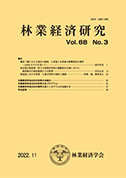All issues

Volume 68 (2022)
- Issue 3 Pages 1-
- Issue 2 Pages 1-
- Issue 1 Pages 1-
Volume 68, Issue 3
Journal of Forest Economics
Displaying 1-5 of 5 articles from this issue
- |<
- <
- 1
- >
- >|
-
2022Volume 68Issue 3 Pages Cover_1
Published: 2022
Released on J-STAGE: March 12, 2023
JOURNAL FREE ACCESSDownload PDF (248K) -
2022Volume 68Issue 3 Pages Toc_1
Published: 2022
Released on J-STAGE: March 12, 2023
JOURNAL FREE ACCESSDownload PDF (248K) -
An ARDL ApproachTetsuya MICHINAKAArticle type: Article
2022Volume 68Issue 3 Pages 1-11
Published: 2022
Released on J-STAGE: March 12, 2023
JOURNAL FREE ACCESSSawmills need to manage the arrival amounts, inventory, and prices of sawlogs to maintain the operating profit and sustainable management of the sawmill. This study examines Akita Prefecture, which has a high harvest volume of sugi logs and a high proportion of sugi sawlogs in sawmills. Autoregressive distributed lag (ARDL) models were applied to clarify the affecting factors of arrival amounts, inventory, and sawlog prices. Citing research findings that the existence of missing variables (lag values), rather than the existence of a unit root, is the cause of the spurious regression relationship, we used the ARDL models to analyze the long-term relationships and the error correction models (ECM). The period of analysis was from January 2005 to December 2020. The findings revealed that the price of sawlogs (sugi, 24-28 cm in diameter) and the lumber price (sugi nuki, special grade) were associated in the long term. Additionally, the amount of sawlogs arriving and consumed were also associated in Akita Prefecture. However, while deciding the amount of inventory and arrival, priority was placed on the consumption of sawlogs or the lumber shipped, and sawlog price had only a weak influence in these processes. Finally, ECM for arrival amounts revealed a faster error correction speed than the price and inventory ECM models.View full abstractDownload PDF (585K) -
Masahiro HAYAJIRIArticle type: Article
2022Volume 68Issue 3 Pages 12-24
Published: 2022
Released on J-STAGE: March 12, 2023
JOURNAL FREE ACCESSFollowing the TEPCO Fukushima Daiichi Nuclear Power Station Accident caused by the Great East Japan Earthquake in March 2011, evacuation orders were issued for 12 municipalities within the Fukushima Prefecture. In this study, we examined changes in the revenue management practices of five forest owners’cooperatives that oversee these municipalities to assess the extent of these changes. Revenue management environments of disaster-affected forest owners’cooperatives vary with geographical characteristics in terms of individual areas. However, recovery initiatives, such as mitigation measures against radioactive contamination, have become key sources of revenue for all cooperatives. Before the Fukushima Accident, a shift in revenue streams from forest maintenance to sales (e.g., wood production) was observed. However, following the Accident, forest maintenance departmental revenues increased dramatically, primarily due to recovery initiatives; this increased the forest maintenance department’s relative importance within the cooperatives’overall revenue structure. Recovery initiatives have resulted in a rise in total revenue. In contrast, this resulted in a considerable range-of-expansion in annual revenue fluctuation. Overall, disaster-affected forest owners’cooperatives have attempted to recover the lost revenues with recovery initiatives as radioactive materials. However, this revenue-stream shift to the one based on recovery initiatives led to a certain degree of management instability.View full abstractDownload PDF (1313K) -
Makoto MATSUZAKI, Katsuhisa KOHROKIArticle type: Article
2022Volume 68Issue 3 Pages 25-31
Published: 2022
Released on J-STAGE: March 12, 2023
JOURNAL FREE ACCESSForestry management entities utilize not only forestry workers but also individual contractors such as forestry-dependent contractors. Since forestry dependent contractors are not regular workers, they may not be covered by the workers’accident compensation insurance system and may be forced to work in a disadvantageous state in terms of health and safety. They do-have access to workers’accident compensation insurance if they join the forestry-dependent contractor organization: however, in this system, forestry dependent contractors must pay high premiums for the insurance fee. The purpose of this study was to clarify the current situation of the forestry-dependent contractor organization and the forestry-dependent contractors who belong to it. The survey results revealed that it is important that the forestry-dependent contractor organization undertake three key activities: implementation of further health and safety measures, adoption of attendance management, and implementation of the recruitment of individual contractors.View full abstractDownload PDF (402K)
- |<
- <
- 1
- >
- >|